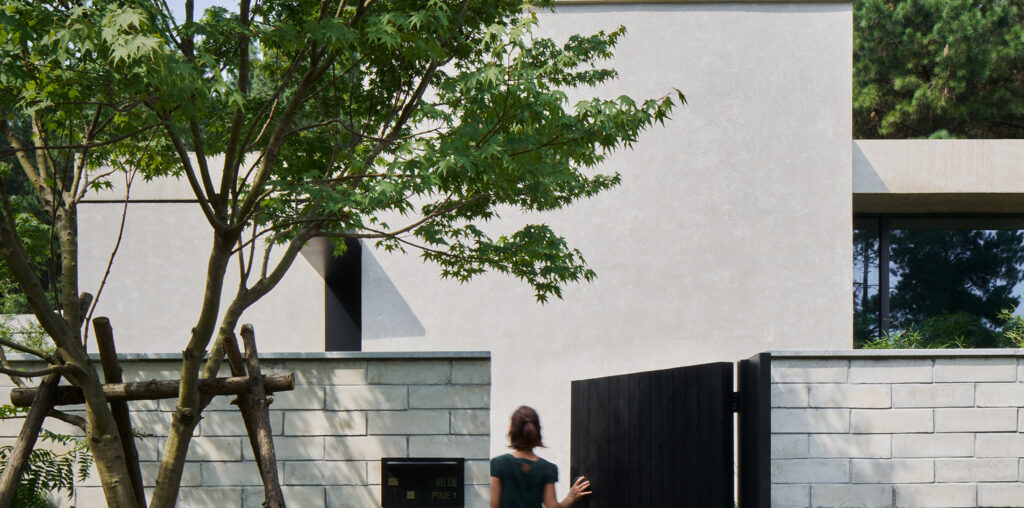

Text description provided by the architects. Anadu Pine Villa is situated in a secluded valley, a two-hour drive from Shanghai, enveloped by pine forests and shielded by a mountain draped in bamboo. This boutique resort comprises just three elegantly designed guest suites, each with panoramic views, complemented by a refined wine and cigar bar. In line with Anadu’s philosophy of “Find yourself in nature,” our objective—from planning to architectural design—is to showcase the unique beauty of the valley’s pine forests. We aim to harmonize with the natural landscape, creating an unparalleled retreat experience exclusive to Pine Villa. The buildings are thoughtfully positioned along the valley’s contours, each oriented to capture unique views. Guests are invited to embrace the gentle valley breeze as they embark on their journey to tranquility.


At the entrance, a bamboo-textured concrete and charred black wood “L”-shaped gate harmoniously merges with the landscape, welcoming guests with open arms—embracing the valley’s greenery on one side and inviting visitors on the other.


Originally, an abandoned old house stood where the wine house now sits. To honor the site’s history, the new building echoes the old structure’s gabled roof, redesigned into a four-sloped form that creates a harmonious, tranquil scale from every angle. The building is divided into two sections: the cigar lounge on the left, enclosed and seamlessly connected to the roof, and the reception area on the right, where the roof appears to float above the mass, allowing natural light to filter in. The double-edged shadow line details along the roof’s eaves serve both functional and aesthetic purposes, managing dripping water while softening the roofline’s sharp tension.


After passing through the relatively enclosed functional spaces, the interior opens entirely. The minimalist, warm material palette features custom wooden furniture and light wood ceiling panels that follow the roof’s form. The slope softens towards the windows, with black flat ceilings extending outdoors, creating a generous shaded space that connects the building with a small plaza facing the pine forest. In pleasant weather, glass doors can be fully opened to integrate the plaza into the indoor space. The walls are entirely glass, maximizing the views, while the northeast dining area faces a quieter hillside, and the semi-enclosed lounge provides a more private atmosphere.



A curved bamboo-textured wall leads guests from the wine house to the guest area, where the hard ground transitions into soft gravel paths, evoking a vacation atmosphere. At the path’s end, a small plaza provides a moment of pause before entering the guest area, enhancing the sense of seclusion. The three minimal standalone structures sit quietly in the valley, surrounded by the forest. Facing staggered walls that obscure the rear of the space, guests are invited to imagine what lies beyond.


As guests walk through the courtyard and winding paths, they experience a series of mysterious moments before reaching the guest rooms. Upon entering, the view dramatically opens up—two concrete slabs face the valley with no obstructions. The interior flows seamlessly with 270-degree panoramic views, offering a fully immersive experience. The rooms are embraced by nature on three sides, each framing its own unique view.



To keep the structure minimal, the buildings are cast from exposed concrete with integrated beams and embedded piping, ensuring no visible ceiling beams, lighting fixtures, or suspended structures. The clean concrete slabs unify the space. The floor slab floats above the valley, respecting and connecting with the terrain, while appearing to hover above it. Between the two concrete slabs, only the serene pine valley is in sight.



Through the glass doors, each room opens onto a private backyard in the pine forest. The eaves extend into a shaded area, blending the indoors with nature. Every guest room has its own floating outdoor deck, offering a further connection to the valley. The landscape design softens the boundaries between the estate and its surroundings, using native valley plants to integrate seamlessly into the environment. Discreet lighting, resembling fireflies, dots the pathways and grounds, enhancing the serene, secluded atmosphere.



Much of the woodwork is crafted from reclaimed wood sourced from local markets, with 80% of the pieces handcrafted by skilled artisans. This repurposed wood is meticulously shaped to harmonize with the scale and spirit of its surroundings, subtly enhancing the preservation and continuation of local craftsmanship.






